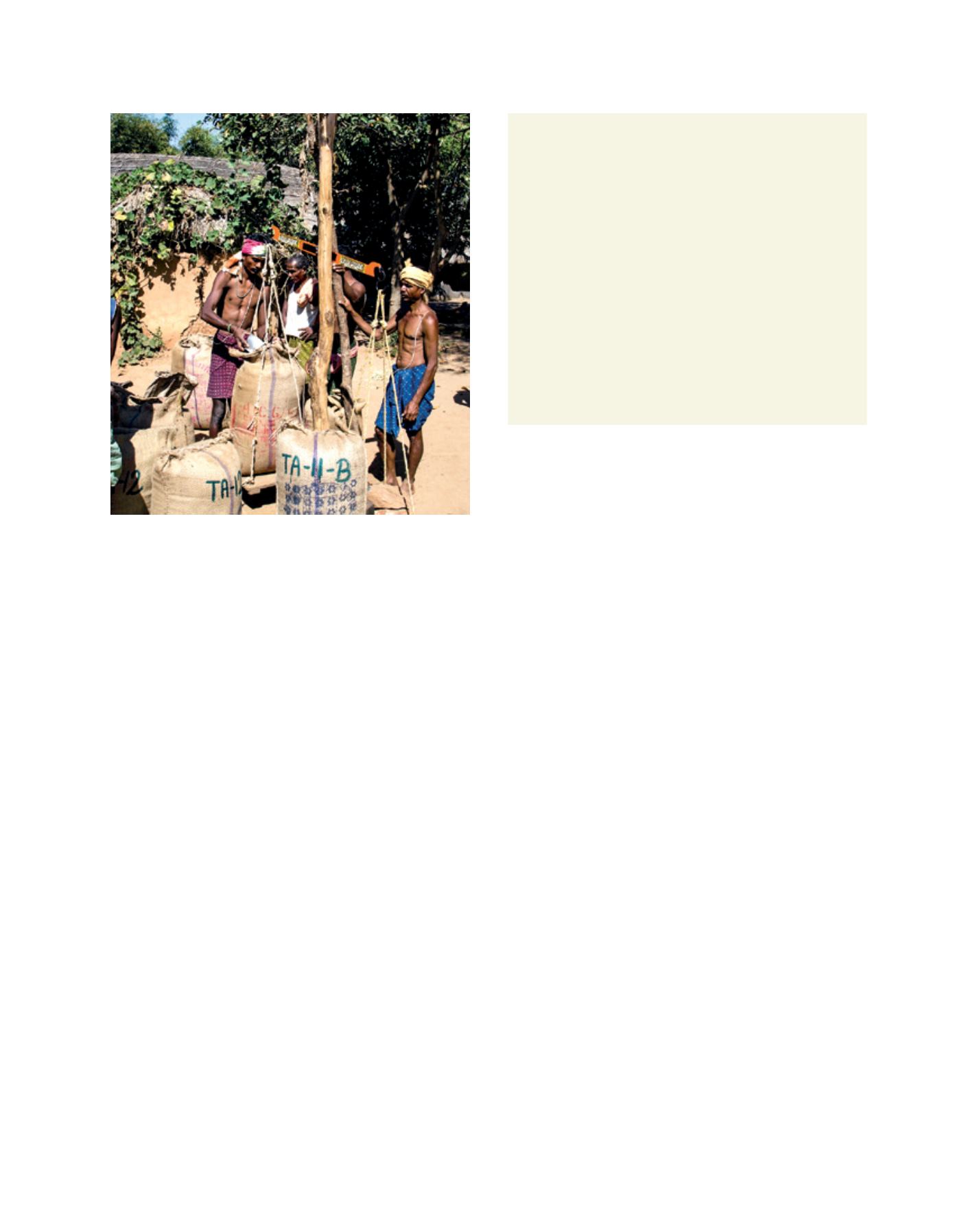

[
] 100
patronize landraces that have many primitive features and
are often photo-insensitive and early maturing.
The landraces growing were found to harbour genes
for biotic and abiotic stresses, aroma and palatability and
hold promise for their utilization in future plant breeding
and biotechnology programmes. Tribal communities have
preferences for these landraces for their cooking quality,
palatability, suitability for value addition, long straw for
thatching and fodder. The farming practices followed by
them are of great value for sustainable agriculture and food
and nutrition security. Often, such traditional knowledge
isn’t largely recognized for sharing of benefits or rewards
accruing to the community for conserving these landraces.
Diversity loss has been observed in rice. During 1955-
1959, the Central Rice Research Institute, Cuttack
collected 1,745 germplasm accessions of cultivated rice,
which is popularly known as the Jeypore Botanical Survey.
Among the collections, some perennial wild species
(Oryza
rufipogon)
, annual wild species
(Oryza nivara)
and natural
hybrids (Spontanea rices) were dominant. In a similar effort
during 1995-1996 by MSSRF, only about 350 landraces of
rice could be collected in the region, indicating a rate of
loss of genetic diversity in a span of 40 years. Changing
economic conditions are attributed to the erosion of knowl-
edge on natural resources in Jeypore tract. Notably, in the
central area of Jeypore tract, recent irrigation facilities have
replaced landraces with high-yielding varieties and influ-
enced traditional agricultural practices.
Realizing the need to develop procedures for recognizing
and rewarding the contributions of tribal and rural families,
particularly those of women, in the conservation and enhance-
ment of genetic diversity, initiatives were taken by MSSRF
since 2000 onwards to conserve, cultivate, consume and
commercialize biodiversity with a special focus on landraces
of rice, in accordance with the provisions of the Convention
on Biological Diversity. The selfless efforts of tribal communi-
ties of Jeypore tract earned them the Equator Initiative Award
in 2002 at the World Summit in Johannesburg. The award has
been a significant motivational factor for the tribal community
of Jeypore in Orissa to initiate an endogenous and sustain-
able mechanism of people’s self-organizing actions into a local
social system. Thus, it resulted in the formation and registra-
tion of a farmers’ association, ‘Panchabati Grama Unnayan
Samiti’ (PGUS) in 2003. PGUS was formed to popularize the
success achieved in harnessing science and technology to
make the villages self-reliant in agriculture and food security.
PGUS has been active since then in terms of dissemi-
nating appropriate technologies for conservation and
production enhancement of local crops (rice, millets,
pulses), enabling food security to a great extent. Access
benefits from entitlement schemes have been enhanced
through effective linkage. Tree plantation was promoted
PGUS, both as avenue and in barren forest land, mainly
through the supply of saplings at household level. In-situ
conservation of 40 traditional rice landraces has been
demonstrated in two villages, especially identified by PGUS.
Seventeen landraces have been raised by 23 farmers in 13
acres (primarily for their own consumption). Machhakanta,
Kalajeera and Haladichudi landraces have been popularized
in a larger area. Kalinga Kalajeera Dhan Utpadak Samabya
Ltd, with its linkage to Orissa rural development and
marketing society, helped in marketing substantial quanti-
ties of Kalajeera rice variety. Village grain seed banks have
been established by PGUS to provide farmers with access
to quality seeds in time.
Hence, community institutions based biodiversity
management and empowerment processes including
research, development and legal support mechanisms are
imperative and have been critical for hindering genetic
erosion, enhancing local resource-based livelihoods and
rewarding community conservation traditions.
National and global recognition for
conservation traditions
The Protection of Plant Varieties and Farmers’ Rights Authority
(PPVFRA), Government of India conferred the Koraput tribal
communities with a Plant Genome Saviour Community Award
in 2007. The Ministry of Water Resources, Government of India
presented the tribal communities of Koraput with a National
Water Conservation Award in 2011.
The United Nations Development Programme Equator Initiative
Innovative Partnerships Award was awarded to the tribal
communities of the Jeypore tract for the on-farm conservation
of biodiversity, during the World Summit on Sustainable
Development at Johannesburg, South Africa in 2002.
The Food and Agriculture Organization declared the
Koraput region as a Globally Important Agricultural Heritage
System in 2012. This award is for maintaining unique tribal
traditional agricultural practices, conservation and utilization
of inherited traditional knowledge for local food security in
relation to cultural diversity.
Tribal men marketing Kalajeera paddy at Koraput: Kalajeera is one of the
rice varieties that has been popularized over a larger area
Image: MSSRF
D
eep
R
oots
















